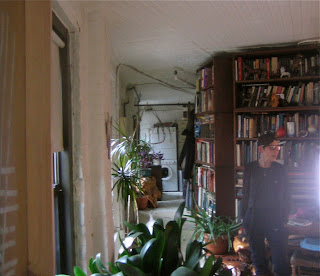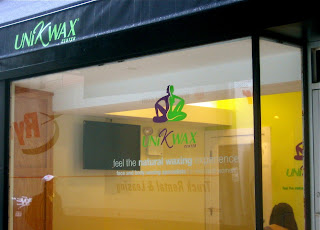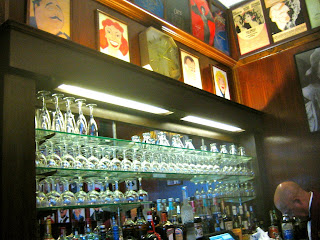There are buildings and apartments that I fantasize about whenever I walk past. One of them is the
Triangle Building, that hulking wedge of brick between Hudson and 9th Avenue in the Meatpacking District. I've often wondered who lives there and how. So when I wandered in off the street one day and was welcomed by long-time resident Ivy Brown, it was something of a dream come true.
 Ivy Brown in her gallery, with work by Tim Groen
Ivy Brown in her gallery, with work by Tim Groen
Ivy runs the
Ivy Brown Gallery, located at the entrance to her long, triangular apartment where she has lived since 1985. She moved into the neighborhood when it was still dark and the air reeked of animal blood. Today, hers is one of only a dozen residential spaces remaining in what is now a transient commercial district.
"I saw an ad in the
Village Voice," she told me. "It said 'triangular loft, 1800 square feet, 18 windows, with a wood-burning fireplace.'" The apartment sounded amazing, but she hesitated to move in. "The neighborhood was really gritty. There were no lights. It was just transvestite prostitutes and meatpackers. There was blood and fat all over the streets, and big buckets of what they called inedibles.
It smelled to high heaven and every time I looked out a window I managed to catch a glimpse of the Bone Truck." The Bone Truck hauled away the inedibles. It had no top and chunks of fat would fly off it when it went by. Within two years of living there, Ivy became a vegetarian.
 Ivy Brown Gallery, with work by Tim Groen
Ivy Brown Gallery, with work by Tim Groen
The promise of 18 windows is hard to turn down (years later, after expanding, she's got a total of 25) and life in the Meatpacking District would soon prove to be a wonderful adventure. A great bunch of guys lived upstairs. They worked for
Spin magazine or made jewelry. One had a prison cell for a closet. It was leftover equipment from when the apartment had been Lenny's Attic, "
a kind of S&M golden shower sort of environment," Ivy explained.
The prison-cell closet had a drain at the bottom.
 Ivy's bathroom door
Ivy's bathroom door
Was that
Lenny Waller who ran the Attic? Maybe. Ivy remembers Lenny well from when he ran the basement clubs--Hellfire, Manhole, The Vault--where Ivy's fusebox was located. During a sudden blackout, she hurried downstairs in bathrobe and slippers, and Lenny led her through the club to the fusebox.
"
There was a 300-pound woman chained to the ceiling and a guy with a cat o'nine tails whipping her," Ivy recalled, crossing her eyes. "Anyway, turns out, our fusebox had exploded. We had to call the Con-Ed emergency guy. So I'm standing there, trying to make polite conversation with Lenny while all these people are beating each other. My slippers are sticking to the floor. I mean it's like Elmer's glue everywhere. They've got a chain-link spider web along the wall. So I say, 'That's a really nice piece.' And Lenny says, 'Yeah, it's great, it holds two people!' The Con-Ed guy wasn't even fazed. I guess he'd seen everything."
When Ivy's last male roommate moved out and only women were living in the apartment, they enlisted Hellfire's doorman as protection. Charlie was a big leather guy with a German Shepherd and a heart of gold.
He invited them to the Slave Auction where they met "a gentleman called Pony Boy, in his late 60s, sitting at the bar drinking orange juice, butt naked and wearing a saddle," along with more of the downstairs regulars.
 The bedroom
The bedroom
Ivy was also protected by the transgender sex workers on the block. On the first floor of the Triangle Building, she explained, was a transgender crisis center called Project First Step and across the street was Lee's Mardi Gras, the biggest boutique for crossdressers in town. At 14th was Dizzy Izzy's bagel place, where all the girls hung out. This was their stroll and on weekend summer nights they flourished. "
I'd look out my window and see maybe 40 trannies," said Ivy, "almost naked, wearing trenchcoats they'd pull open when the cars came by. And those girls were gorgeous."
Ivy gave them clothing and makeup, and always made sure she had a mirror on the bicycle she kept outside so the girls had someplace to check their lipstick. Her favorite was called Taxi. "Whenever she crossed the street, all the others would scream, 'Taxi! Taxi!' And cabs would stop. They got a kick out of that."
There was little danger in the neighborhood back then. "There was no one to rob," said Ivy. "You wouldn't rob a tranny, you'd get your head bashed in. Today there's much worse crime here." But the sex workers' customers could be threatening.
"Walking west,
once you left 8th Avenue, the world ended. The girls always saw me to my door and made sure I got home safe. If a guy bugged me, two girls would flank me and scare him away." One night, in an ice storm, Ivy fell on the sidewalk. She was dazed. "Then, all of a sudden, I was like a kitten being picked up by the scruff of the neck. Two big girls lifted me up and carried me home. They never asked me for anything. Never crossed a line. They had my back."
 Photos by Mr. Means in the bathroom
Photos by Mr. Means in the bathroom
Another person Ivy met on the street was Dorothy. An immigrant from the Bahamas, she was called "Grandma" by the guys who ran the downstairs gay bar
J's Hangout, where Dorothy collected cans. Eventually, she became Ivy's adopted grandmother. For 20 years they had brunch together every Sunday and went to the LGBT Metropolitan Community Church where Dorothy ran the food pantry. Five years after Dorothy's passing, Ivy still serves food at the church on holidays and hopes that her adopted grandmother is proud of her.
"
This building introduced me to a whole other level of my life," she said, thinking of the many people who enriched her over the years in this place.
 Hallway full of windows and plants
Hallway full of windows and plants
Hollywood has often been attracted to the building. Ivy recalls washing Michael Douglas' bloody shirt during the filming of
Fatal Attraction here, and she tells of the time she had a house guest during the shooting of Ed Harris' suicide scene in
The Hours. "My old college professor was sitting in the living room and he was pretty drunk. He saw the body go by and freaked out. He called me in a panic,
'Someone jumped out the upstairs window! And now others are following!' They had multiple dummies of Ed Harris they kept throwing out the window. He couldn't figure out what was going on."
No stranger to death, the apartment is haunted, she told me, maybe from its days as a Civil War hospital. Ghosts linger. Now and then, Ivy still finds one of the thousands of straight pins that once littered the floorboards, leftovers from some manufacturing--there was a lot of that here, from the original resident Herring Safe & Lock Co., to the Follett Time Recording Co., the Hanson Granule Co. (makers of bromide-seltzer), and the Elite Metal Co., makers of "Fancy Metal Goods" in the 1920s (
see pic).

People ask Ivy if she hates what has happened to the neighborhood, with so many people she loved swept away and no place for them to exist again among the high-luxury hotels and boutiques.
She responds, "I choose not to live with hate, but I do miss it.
I miss my neighbors, the people who've been thrown out. I miss the neighborhood. On Sundays in summer, we'd barbecue on the sidewalk and open the fire hydrants. It was old-fashioned. I used to walk to Western Beef, where the Apple store is now, in my pajamas and a pair of boots to get a quart of milk. Now if I go out without my hair combed, everyone's looking me up and down."

She was unhappy here for awhile, but it got better when she got her dog, Buster. He likes going into the clothing boutiques because they have biscuits, and he introduced Ivy to the people there.
"Having the dog re-humanized the neighborhood for me. Before that, it was just Us and Them. It was terrible."
And she loves running the gallery she opened in 2001, where she has tea parties and brings people together. Her artists include Kenjiro Kitade who makes a
skull planter in which you can grow a Hibaku Tree from Hiroshima, and
Tim Groen who pairs paint-by-numbers with vintage ads and cut-out captions. Ivy's next show will feature the heartbeat drawings of
Sasaki.

Most of all, Ivy loves life in the Triangle Building, even with the ocean of drunken noise outside, a cacophony that would have drowned out the streetwalkers. ("I never shouted WOO! when I was in my twenties," she said.) The apartment is outfitted with brick walls and plank wood floors. Pipes run along the pressed-tin ceiling. Books and plants overflow everywhere. It has an energy that pulls you through its length, drawing you to its very tip where it seems to thrust uptown, like the prow of a ship.
"Living in an isosceles triangle is supposed to be bad Feng Shui," says Ivy, "so I do things to counteract that.
It's like living in a live body. Things happen here. It makes noises, it leaks, it floods. Sometimes it feels like it cries. It burps. It's got indigestion. Sometimes the electricity undulates. It's not just a normal apartment building, and everyone feels that when they walk in. I respect it. I sage it regularly. It deserves that. It's been so good to me."


























































